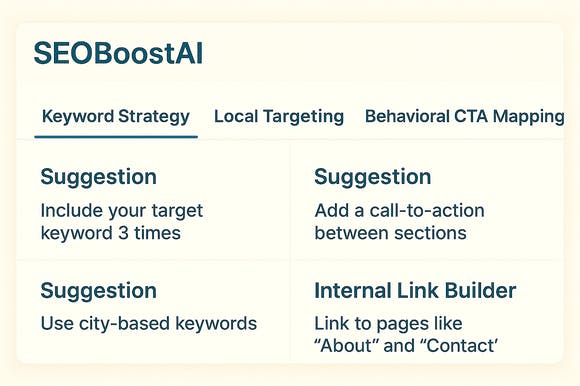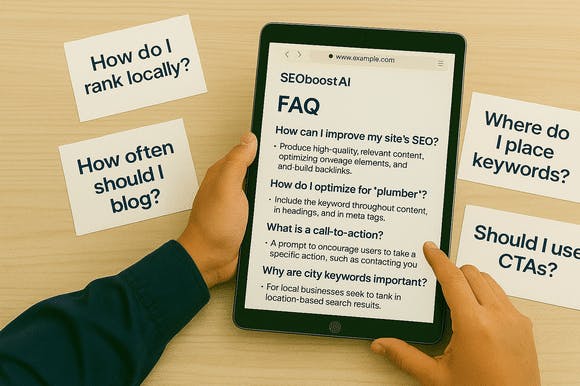Business Owners & Service Providers

Optimize Content, Boost Conversions, and Dominate Search Rankings
In today’s digital-first economy, your website is more than just a brochure — it’s your most important salesperson. For business owners and service providers, the ability to attract qualified traffic and turn visitors into paying customers hinges on the quality and structure of your content. A strategic focus on seo for service providers isn’t just about rankings — it’s about building trust, answering search intent, and driving measurable results.
Whether you offer legal services, home repairs, consulting, or any other expertise, your audience is searching online with a purpose. But generic content won’t cut it. To compete, your site needs website content that converts, engages, and guides users through a clear journey. This means crafting pages with strong calls-to-action, local relevance, optimized headlines, and SEO-driven formatting that aligns with what both users and search engines expect.
SEOBoostAI simplifies this process by helping you implement proven techniques like local seo strategy, behavioral content structuring, and internal linking optimization — all designed to improve performance and increase conversions. It doesn’t just analyze your content; it reshapes it into a high-performing digital asset. Whether you're a local shop, independent contractor, or small firm, these tools empower you to compete with larger players by leveraging smarter, more strategic content.
This guide is your starting point. We’ll show you how to use targeted content optimization tips to turn passive pages into lead-generating machines, boost your visibility, and build real authority in your niche. If you're ready to grow smarter — not harder — you’re in the right place.
What “SEO for Service Providers” Really Means

For business owners and service professionals, SEO is no longer optional — it’s foundational. But “seo for service providers” doesn’t mean becoming an expert in algorithms or digital jargon. It means strategically shaping your online content so it speaks to your ideal customer’s needs while satisfying the way search engines evaluate and rank websites. If your content isn’t optimized, it’s invisible — and invisibility online means lost revenue.
Unlike broad or product-driven SEO, service-based SEO is location-sensitive, intent-driven, and heavily reliant on trust signals. Your potential clients are looking for more than just keywords — they want clarity, confidence, and proof. That’s where website content that converts becomes essential. Service pages, contact sections, FAQs, and even testimonials must be optimized not just for readability but for conversion — guiding users step-by-step toward reaching out or scheduling a service.
Adding a local seo strategy enhances this even further. When your site includes localized keywords, city names, service areas, and structured data, it signals to Google that you're a relevant, nearby provider — boosting your visibility in map listings, featured snippets, and local packs. This is especially important for contractors, medical professionals, consultants, and others who serve clients in specific regions.
By using the right content optimization tips, your website becomes a scalable growth tool. It can generate new leads around the clock, build long-term authority, and reduce your reliance on paid ads. Done right, SEO is not a cost — it’s an investment with compounding returns.
Why Strategic Content Matters for SEO and Conversions

For service providers, the difference between a high-performing website and an underperforming one often comes down to content structure and intent alignment. Search engines don’t just index your site — they evaluate it. They want to see that your content is relevant, helpful, and clearly answers what people are searching for. Without this, even the most attractive website can remain buried on page three of the results. This is why seo for service providers must be rooted in strategy — not guesswork.
When your content is properly structured with H1s, H2s, and keyword-targeted sections, it allows Google to “understand” your page more effectively. But more importantly, it helps potential customers quickly find the answers they’re looking for. A well-implemented local seo strategy doesn’t just mention your city or services — it contextualizes them. It shows you serve “HVAC repairs in Austin” or “family law consultations in Denver,” helping both users and search engines recognize you as a trusted local provider.
Strategic content also drives engagement, which is now a key signal in modern SEO. When users spend more time on a page, click through internal links, or complete a conversion goal, Google interprets that behavior as a sign of quality. That’s where website content that converts becomes crucial. This type of content anticipates user objections, answers key questions, and guides action — often with optimized CTAs, testimonials, service breakdowns, and internal navigation built around user behavior.
Neglecting content optimization means leaving revenue on the table. With SEOBoostAI’s AI-driven systems, you can apply content optimization tips that increase readability, reduce bounce rates, and boost the effectiveness of every section on your website. Over time, this leads to better rankings, more qualified leads, and a lower cost per acquisition. In short, the right content does more than inform — it earns.
How to Structure Content That Converts for Service Providers

To drive real results online, business owners and service providers need more than just information on their website — they need strategic content that turns interest into action. Structuring your content correctly improves both SEO performance and customer conversions. Done right, every section of your website becomes a purposeful step in your sales process.
Begin with a page title that directly reflects your offering. For example, a generic “Our Services” title is vague and low-converting. A better alternative is “Roof Repair & Replacement Services in Tampa” — which immediately supports your local SEO strategy and adds clarity for both Google and your visitors. This should be followed by an opening paragraph that highlights your value proposition, including what problems you solve, who you help, and what action users should take next.
After the intro, use strong H2 and H3 headings to break down your services by category or specialization. Each service section should include:
- A brief description of what the service includes
- Who it’s designed for (residential, commercial, etc.)
- Why your business is qualified to offer it
- A benefit-focused CTA (e.g., “Book Your Free Inspection Today”)

These service blocks serve multiple purposes: they educate potential customers, answer search intent, and give Google clearly structured content it can rank. This structure reinforces your authority while building trust — essential for creating website content that converts.
Don’t underestimate the power of visual spacing, short paragraphs, and bold headlines. Walls of text repel users, while clean layout encourages engagement. Add client testimonials, certifications, or relevant badges within or near your service descriptions to increase credibility. This is especially effective for high-trust industries like finance, legal, or home services.
Your CTAs should appear more than once — ideally at the end of each service block, after key testimonials, and again at the bottom of the page. For example, “Request a Free Quote” or “Speak to a Specialist” are simple, high-converting prompts. Ensure these CTAs are visually distinct and easy to access, even on mobile devices.
Behind the scenes, internal linking plays a major role. If your HVAC page mentions “emergency repairs,” that phrase should link to a deeper emergency repair page. If you note “business tax prep,” link to a dedicated tax services page. These internal links strengthen your site’s structure while improving session time — a valuable factor in seo for service providers.
When every section of your page is designed for clarity, action, and connection, you’re not just writing content — you’re building a customer journey. Strategic layout bridges the gap between traffic and trust, leading to more qualified leads and fewer lost opportunities.
Top SEOBoostAI Features That Support Business Owners

Running a service business means wearing many hats. Between answering customer inquiries, managing staff, and keeping projects on track, there’s often little time left for SEO — let alone structured content creation. That’s exactly why SEOBoostAI was designed: to help business owners and service providers create content that ranks well, converts consistently, and adapts to user behavior — without needing to master SEO yourself.
One of the most impactful features is its ability to generate website content that converts — not just generic filler, but content that speaks directly to your audience’s needs and motivates them to take action. The system guides you to highlight your competitive advantages, build trust, and address objections across every page. Each section is structured to maximize engagement and naturally move visitors toward a decision point — whether that’s booking a call, requesting a quote, or making a purchase.
For local businesses, the integrated local SEO strategy engine is a game-changer. It helps you identify the most relevant city- and region-based keywords, then structures your content to match the way local customers search. It also helps you build locally optimized landing pages, service-area descriptions, and Google-aligned content that supports your appearance in map results and location-based searches. Instead of generic service pages, you end up with location-enhanced content that drives foot traffic, phone calls, and local visibility.
SEOBoostAI also ensures you don’t overlook one of the most powerful — yet often ignored — elements of SEO: internal linking. With smart suggestions based on topic relevance, it identifies the best opportunities to connect service pages, about pages, testimonials, FAQs, and more. These links not only improve navigation and reduce bounce rates, they also strengthen your site’s topical authority — an increasingly important signal in seo for service providers trying to compete with larger agencies or directories.

But structure alone isn’t enough. SEOBoostAI uses behavioral SEO insights to enhance how users interact with your content. The system detects where drop-offs are likely to happen and suggests changes like repositioning CTAs, shortening blocks of text, adding credibility elements, or embedding internal links at key friction points. These enhancements are based on real-world engagement patterns — not assumptions — and they’re built directly into your editing workflow so you don’t miss critical opportunities to improve conversions.
To further boost performance, the platform provides built-in content optimization tips for every section you write. These include keyword usage recommendations, heading structure guidance, meta content coaching, and even readability prompts — all tailored to beginners who don’t want to sift through complicated SEO jargon. Whether you’re revising an existing service page or building a new one from scratch, these prompts help you create search-ready, human-friendly content every time.
From solo professionals to multi-location service businesses, SEOBoostAI delivers a practical, scalable content system that helps you compete in search, build credibility, and convert more visitors — all with less effort and no dependency on outside agencies. It doesn’t just optimize your content. It empowers you to build a smarter website, one page at a time.
Common Mistakes That Hurt Service-Based SEO

Even well-intentioned service providers often make costly SEO errors that weaken their visibility and leave opportunities on the table. These mistakes don’t always stem from a lack of effort — they usually result from a lack of structure. Without clear guidance, it's easy to misalign your content with search expectations, leading to lower rankings, less engagement, and fewer conversions. Fortunately, most of these issues are fixable with the right framework and tools like SEOBoostAI.
The first and most damaging mistake is failing to match search intent. Many service pages are written from the business’s perspective rather than the customer’s. Instead of answering real questions or solving specific problems, the content lists credentials, processes, or vague marketing phrases like “tailored solutions.” This disconnect prevents users from engaging and tells search engines the page lacks relevance. SEOBoostAI helps correct this by structuring content around audience intent — guiding users step-by-step toward the actions they’re already searching for, and delivering website content that converts.
Another critical error is underutilizing location-based signals. Service businesses often forget to mention where they operate, or they bury that information deep in the footer. If your site doesn’t reinforce city, region, or neighborhood terms across your pages, you miss out on one of the biggest ranking factors for local discovery. SEOBoostAI automatically integrates local SEO strategy throughout your content — optimizing headers, introductions, and service descriptions to trigger local map listings and nearby search visibility.
Many business owners also misunderstand keyword usage. Either they stuff pages with repeated phrases, damaging readability and trust, or they avoid keywords altogether for fear of sounding unnatural. Both extremes limit your success. A properly optimized service page should include your primary terms 2–3 times per 200 words, with supporting long-tail phrases spaced naturally. SEOBoostAI’s embedded content optimization tips show you exactly where and how to use keywords — keeping your writing natural while boosting relevance.

Internal link neglect is another costly oversight. Pages that don’t link to each other create dead ends for both users and search engines. This isolates content, reduces crawl efficiency, and fragments your site’s authority. For example, if your “AC Repair” page doesn’t link to “Emergency HVAC Services” or “Maintenance Plans,” visitors may never discover those options — and Google may not either. SEOBoostAI addresses this with intelligent link suggestions based on context and flow, helping you build a connected experience across all content types — a key tactic in seo for service providers.
Finally, conversion leakage happens when pages lack clear, compelling calls-to-action. A service page that doesn’t tell users what to do next — whether it’s “Book Your Free Inspection” or “Request Same-Day Service” — forces visitors to guess their way forward. This hesitation often results in abandonment. SEOBoostAI not only identifies where CTAs should go, it helps craft conversion-ready prompts based on behavioral best practices. The result: fewer missed opportunities and a smoother path to revenue.
Correcting these mistakes doesn’t require a redesign or massive rewrite. With a structured approach and the right tools, service providers can transform underperforming pages into high-impact content that gets found, gets read, and gets results.
Final Thoughts: Build Authority, Trust, and Results with Smart Content

Today’s service-based businesses face fierce competition — not just in their local market, but online. Every potential customer is searching with intent, comparing options, and deciding who to trust — often within seconds. That’s why your content can’t just exist. It must work. It must rank well, resonate deeply, and lead users to take action. And that’s exactly what seo for service providers is designed to do when executed correctly.
When you use tools like SEOBoostAI, you’re not just producing more content — you’re building a strategic foundation that supports long-term growth. Every page you optimize becomes a digital asset, working silently in the background to attract qualified leads, establish credibility, and move customers closer to booking, calling, or converting. This isn’t about chasing SEO hacks. It’s about leveraging a proven system that aligns with how people search, how Google evaluates content, and how modern businesses grow online.
More importantly, SEOBoostAI ensures you’re not doing it alone. Instead of relying on scattered advice, outdated blog posts, or expensive consultants, you get real-time guidance on keyword placement, page structure, content optimization tips, and how to write website content that converts. It shows you how to speak your customer’s language, answer their most pressing questions, and lead them confidently to your services.
For service providers who operate in specific cities or regions, the built-in local SEO strategy capabilities are especially powerful. These ensure your content doesn’t just rank for broad terms — it ranks for terms that matter to your business, like “roofing contractor in Dayton” or “small business bookkeeping in Miami.” This is the kind of search visibility that drives phone calls, contact form submissions, and real local business growth.
You don’t need to be an expert. You just need a system that was built to work for you — one that removes the friction, simplifies your content strategy, and gives you back your time. SEOBoostAI was created with that exact goal in mind. Whether you're building your first service page or optimizing an entire website, it empowers you to create smarter, faster, and with complete confidence.
In a world where trust is earned online first, your content is your handshake. Make it count.
Frequently Asked Questions

How can SEO help my service business attract more local customers?
SEO helps your business appear in search results when local customers are actively looking for services like yours. By using a strong local SEO strategy — including city-based keywords, location pages, and structured content — you improve your visibility in map listings and local search results. This means more website visits from people in your area who are ready to hire or contact you.
What makes content “conversion-focused” for service providers?
Conversion-focused content anticipates what your audience needs, answers their most pressing questions, and leads them to take action. With website content that converts, your pages aren’t just informative — they’re designed to guide visitors toward booking a consultation, requesting a quote, or calling your business. This includes using persuasive CTAs, structured service descriptions, and trust-building elements like testimonials.
Do I need a blog to benefit from SEO?
While blogs can support your SEO strategy, they aren’t required for success — especially for service-based businesses. Your core service pages, location pages, and FAQs can generate strong results when they’re optimized using seo for service providers. If you do choose to add a blog, SEOBoostAI can help you structure posts for traffic, engagement, and authority.
What if I don’t know which keywords to use?
That’s where SEOBoostAI simplifies the process. It provides built-in content optimization tips and keyword guidance based on your industry, location, and audience intent. You’ll know exactly which short-tail and long-tail keywords to include, how often to use them, and where they should appear on the page.
How does SEOBoostAI save me time compared to doing it manually?
Instead of researching keywords, writing from scratch, and second-guessing your structure, SEOBoostAI delivers a complete framework. It helps you create, organize, and optimize your content from the ground up — faster and with better results. You’ll spend less time trying to figure out SEO and more time seeing results from high-performing content.